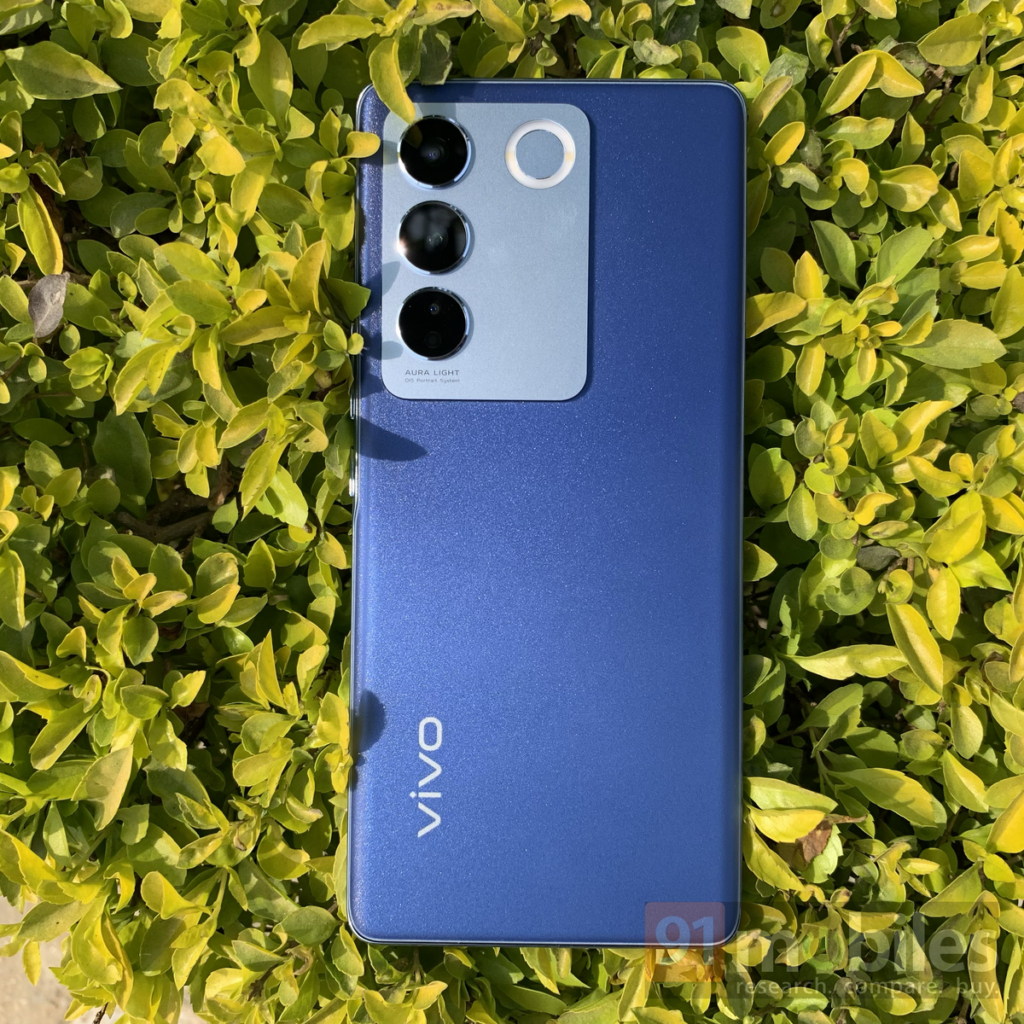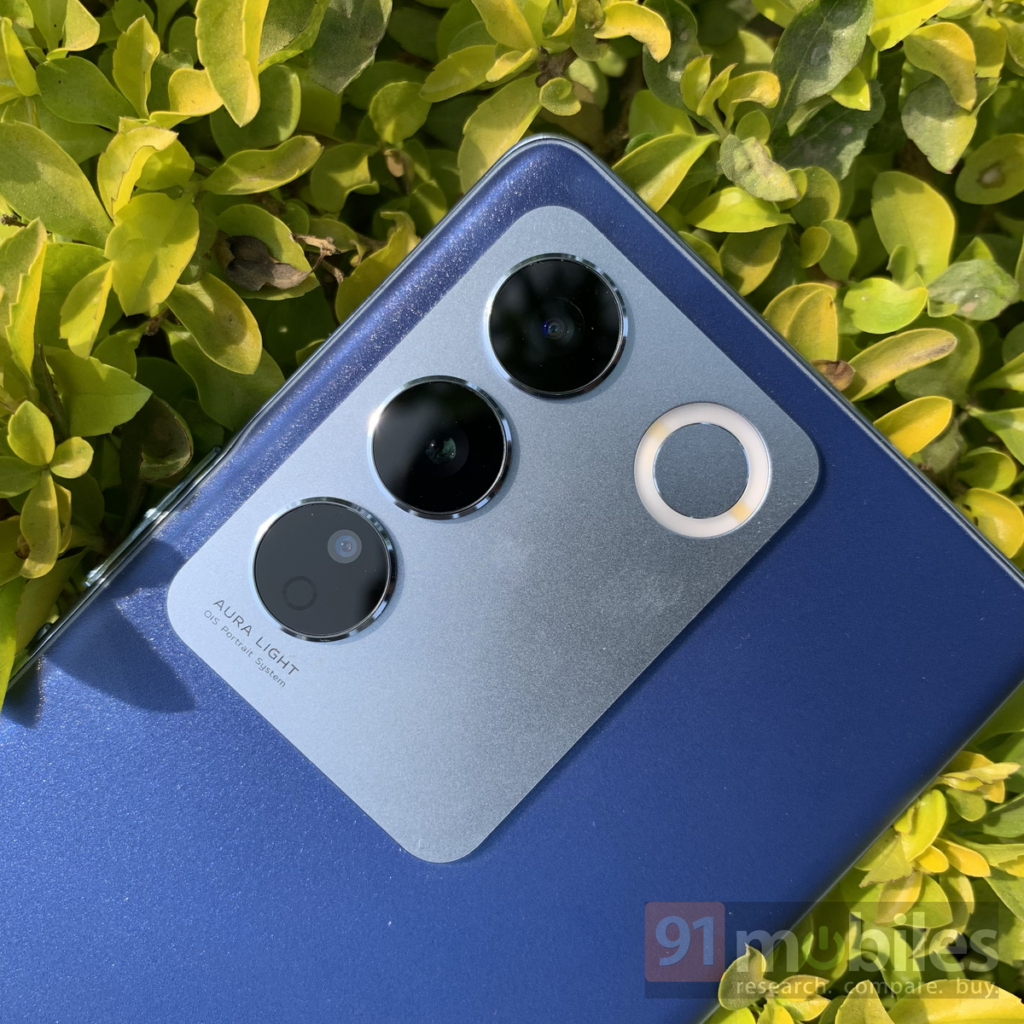In keeping with the six-monthly refresh cycle of the V-series, Vivo has introduced the V27 Pro smartphone in India. The handset succeeds the Vivo V25 Pro (review) with refreshed and new features in tow. The new V-series offering comes with a slightly updated design as well as performance and camera bumps. All of this does sound good, but can the phone keep up with the likes of the competition as the “value buy”? Read on to find out in this Vivo V27 Pro review.
Verdict
The Vivo V27 Pro may not have the best performance and speakers in the segment, but it comes across as a good budget flagship for most buyers. The handset boasts a striking design, a lovely screen, terrific battery life, dependable cameras, and decent performance.

The lowdown
- Design-wise, the Vivo V27 Pro is not significantly different from its predecessor V25 Pro. It still uses the aesthetically-pleasing 3D curved screen, which bodes well for the handset’s slim form factor. The phone comes in at just 7.36mm in thickness. This makes the device comfortable to wield, but on the downside, I found it slippery. The sleek plastic frame doesn’t offer a good grip over the phone. Around the back, the phone has a matte-finish colour-changing glass. I was sent the Magic Blue variant for review, and it changes its shade to dark blue from light blue when sunlight hits the surface. It looks good, but what I really liked about the device is the matte finish. The latter offers a good in-hand feel and ensures that the phone stays clean from sweaty fingerprints or smudges.

- The Vivo V27 Pro also sports a large rectangular camera housing, which has a shiny finish instead of matte, on the rear panel. The housing doesn’t sit flush with the chassis, and as a result, the handset wobbles while lying flat on a surface. Moving on, the phone comes with an in-display fingerprint scanner, which unlocks the device in a jiffy, and a USB Type-C port for charging and data transfer. The port can also be used for listening to music through wired earphones. On the right of the frame, the phone has volume and power buttons, which are easy to reach with one hand. I didn’t have to resort to finger gymnastics to adjust the volume. However, the same cannot be said for the display.
- The Vivo V27 Pro sports a large 6.78-inch AMOLED display, which despite its high screen-to-body ratio, is not suitable for one-hand usage. Unless you resort to finger gymnastics, reaching the corner of the panel will be a task. Be that as it may, it is a gorgeous panel that offers an immersive viewing experience with its razor-thin bezels and a rather small centred punch-hole setup. The display bears FHD+ (1,080 x 2,400) resolution, 120Hz refresh rate, Widevine L1 certification, and HDR10+ support. It outputs crisp and visually-appealing colours, which look good even from an angle. The outdoor visibility of the handset is also impressive. I faced no issues using the device outdoors under direct sunlight. As for the 120Hz screen refresh rate, it worked well across the UI and supported apps. However, for the price, the Vivo V27 Pro’s single bottom-firing speaker sounds average at best. It is loud but lacks stereo experience, and there is no Dolby Atmos support either.

- Moving on, the Vivo V27 Pro has MediaTek Dimensity 8200 SoC ticking at its core. It is a capable high-end chipset with a clock speed of 3.1GHz and an ARM Mali-G610 MC6 GPU. The chipset is paired with 8GB / 12GB of LPDDR5 RAM and 128GB / 256GB UFS 3.1 storage. While the storage isn’t expandable, the phone can add up to 8GB of virtual RAM using the portion of the storage. Before I get to real-world usage, here’s a quick look at the benchmark results:

- The V27 Pro scored 8,39,769 points in AnTuTu. In Geekbench’s single-core and multi-core tests, it managed 1,213 and 3,681 points respectively. While the scores look impressive, the handset’s performance throttles up running 50 threads for 30 minutes in the CPU Throttle benchmarking test. This is evident in the phone’s usage as well. The handset would slow down and heat up a bit when put under intense loads like running multiple apps in the background and playing games on the trot. But, other than that, the device handled almost everything thrown at it without any hiccups. It was quick to launch apps and run games like Asphalt 9, Subway Surfer, and Virtua Tennis Challenge smoothly. The handset also offered a seamless multitasking experience with a handful of apps open in the background.
- Talking about the cameras, the Vivo V27 Pro ships with a 50MP primary sensor, which is down from 64MP from its predecessor. However, the sensor is a custom Sony IMX766V instead of a Samsung GW1 and comes with a bunch of new features such as portrait with aura (LED) light and wedding-style portrait. The latter is an India-exclusive feature designed keeping in mind the colour palette of Indian weddings. Unfortunately, I couldn’t test it at a wedding. The handset also sports a secondary 8MP wide-angle and a third 2MP macro sensor in the triple camera setup at the back. Up front, you have a 50MP snapper for selfies and video calling.

- Except for the macro sensor, which does not work very well, I was very impressed with the Vivo V27 Pro’s photography skills. The 50MP rear and front cameras both were quick to focus and process images shot in daylight. The images may look under-exposed at times, but in general, the cameras did a good job with detail and colour accuracy when the sun is out. The highlights, shadows, and skin tones were up also to the mark. The portrait mode also does a decent job with edge detection of the subject in focus and blurring the background. The focal length can be adjusted by tapping on the ‘f’ icon on the camera layout of the portrait mode. In the dawn and night, the handset does well to retain as much detail as possible with minimum noise. That said, colours might not look accurate. The front camera also tends to smoothen out the facial detailing in low or artificial lighting. As for the 8MP wide-angle sensor, it isn’t extraordinary but produces some likeable shots when there is enough light.
- The Vivo V27 Pro houses a 4,600mAh battery, which can comfortably last for a day and then some for casual users. If you are a power user who loves to stream movies / web series on a small screen, chat, play games, and check social media accounts actively, then the handset can see you through to the day between charges with 20-25 percent battery remaining. On the PCMark battery test, the handset scored 15 hours and 32 minutes, which is quite impressive. The phone doesn’t support the fastest wired charging, but the 66W fast charging solution is respectable enough. The charger is bundled in the box and takes less than an hour to juice up the device from 0 to 100 percent.
- Software-wise, the Vivo V27 Pro runs the latest FunTouch OS 13, which is based on Android 13, out of the box. The new Vivo Android custom skin comes with Android’s Material You theme engine, which allows you to customise UI and system colours. It also comes with a new iManager app that helps you monitor app usage and keep the phone’s thermal in check. Then there is an AQI card in the weather app for health-conscious users, new wallpapers, and additional privacy and security features, such as hiding selective photos and videos from the gallery and keeping an app pinned to the screen to prevent others from using the device. As impressive as it may sound, I wish the FunTouchOS 13 had less bloatware and slightly better animations.
Final verdict

The Vivo V27 Pro doesn’t come across as a new smartphone. The handset feels more like an iterative upgrade to the Vivo V25 Pro from August last year, with a marginally bigger screen and a camera module that blends in more seamlessly with the design for a premium look and feel. The performance of the new V-series offering has also been notched up a little, while the cameras seem to be doing a better job than before. That said, the phone still has a few things missing like stereo speakers, Dolby Vision, Dolby Atmos, and an IP rating. Moreover, the handset’s performance is not as good as some of its competitors, including the recently launched OnePlus 11R (review). The latter comes with a more powerful Snapdragon 8 Gen 1 chipset ticking at its core, priced marginally higher at Rs 39,999 for the base variant.
The Vivo V27 Pro, in contrast, is available starting at Rs 37,999. If you can’t stretch your budget and are looking for a stylish phone with capable cameras for a mid-range price, then the Vivo V27 Pro might serve you well.
Editor’s rating: 3.5 / 5
Pros
- Gorgeous design
- Nice AMOLED display
- Good battery life
- Capable cameras
Cons
- Performance could have been better
- Bloatware
- No stereo speakers
The post Vivo V27 Pro review: a capable mid-ranger first appeared on 91mobiles.com.



0 Comments